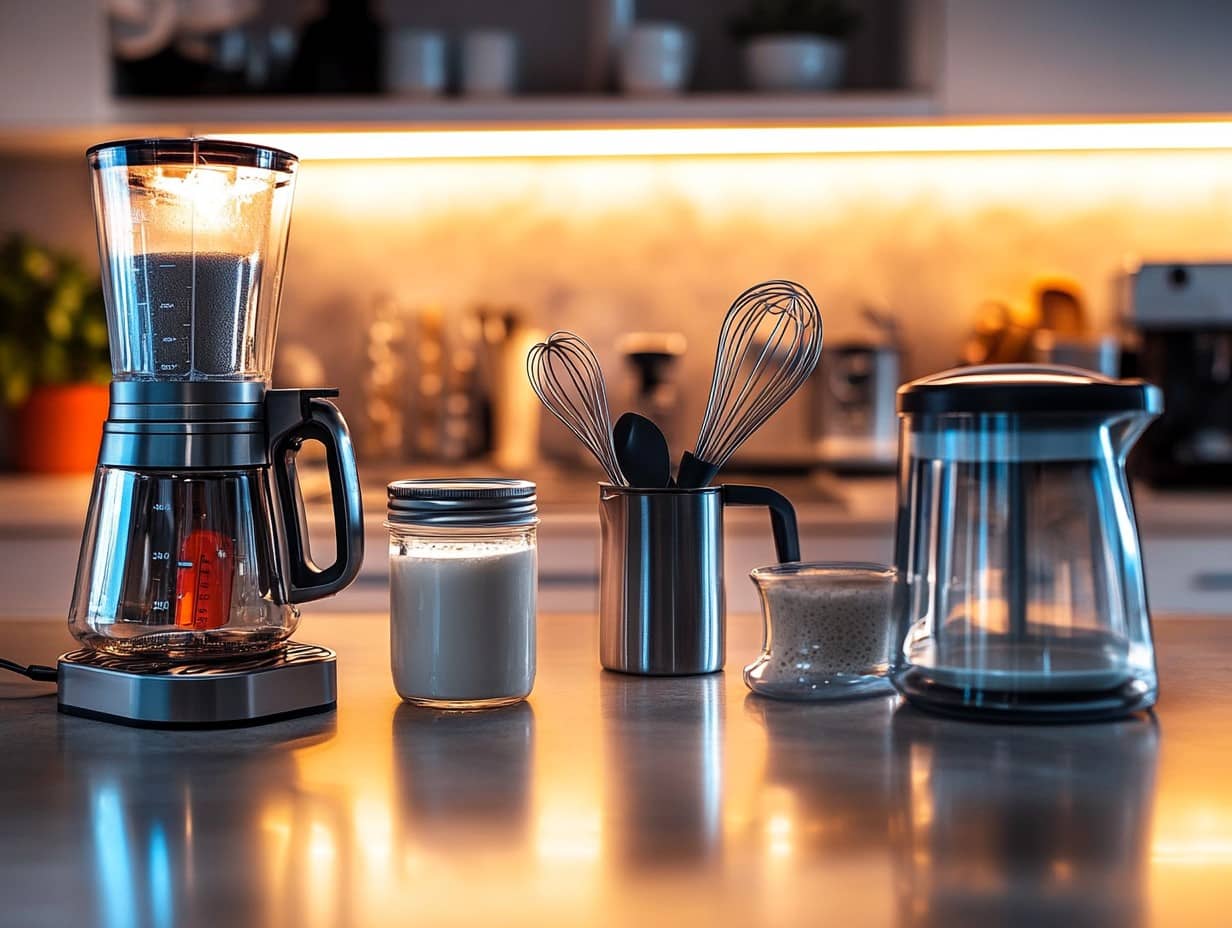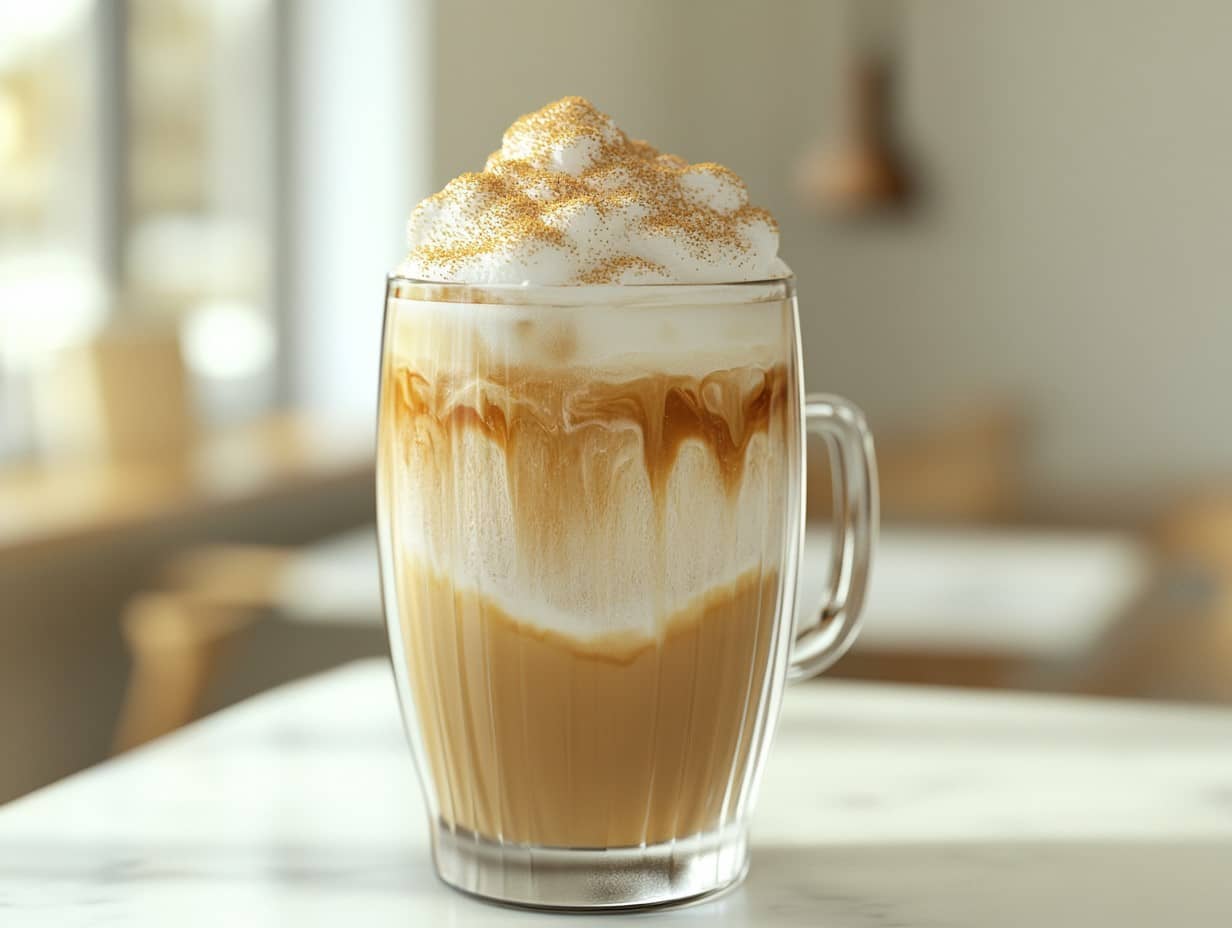Cold foam has quickly become a superstar in the coffee world, delighting taste buds with its creamy texture and irresistible charm. Whether you’re topping off a cold brew or adding flair to your favorite iced latte, mastering cold foam at home can elevate your coffee game. Let’s explore everything you need to know to make perfect cold foam, one frothy step at a time.
What is Cold Foam?
Cold foam is a luscious, airy layer of milk foam created specifically for cold beverages. Unlike hot foams in lattes and cappuccinos, cold foam is prepared without heat, preserving the frothy texture while staying cool. Think of it as the silky cousin of whipped cream light, unsweetened, and ideal for enhancing iced drinks. If you’re curious about the ingredients, you can explore what cold foam is made of for a deeper dive.
The Origin and Popularity of Cold Foam
Cold foam wasn’t always a household term. It gained fame thanks to coffee giants like Starbucks, who introduced it as a sophisticated alternative to whipped cream for cold drinks. Its unique texture and ability to float atop beverages without melting immediately made it a hit. Today, it’s a staple for coffee enthusiasts seeking an indulgent yet refreshing experience. If you’d like to recreate this experience, check out how they make cold foam at Starbucks.
Key Characteristics of Cold Foam
Cold foam is all about balance. It’s thick but not heavy, creamy yet not overly rich. It’s versatile enough to pair with various drinks, from cold brews to iced teas. Best of all, it holds its shape on top of your drink, creating an Instagram-worthy layer of frothy perfection.
Tools You Need to Make Cold Foam
You don’t need a professional barista setup to whip up cold foam at home. With a few simple tools, you’ll be crafting creamy foam in no time. Discover some handy tips for making cold foam at home, even without professional barista equipment.
Essential Equipment for Home Baristas
- Milk Frother: Handheld frothers are compact, affordable, and easy to use, making them the top choice for beginners.
- Blender: A small blender or immersion blender can achieve consistent, fluffy foam in seconds.
- Jar with a Lid: Believe it or not, a simple mason jar can work wonders. Just add milk and shake until frothy.
- Whisk: A manual whisk is a great fallback option, though it takes a bit more elbow grease.
Choosing the Right Milk for Cold Foam
Milk choice plays a huge role in the quality of your foam. Whole milk is the gold standard for its richness and protein content, which helps create thick, stable foam. If you prefer a lighter option, 2% milk is a good alternative. For dairy-free drinkers, oat milk often froths well, especially if it’s fortified with extra protein.
Ingredients for Making Cold Foam
Cold foam may seem fancy, but it requires just a handful of basic ingredients. Wondering if cold foam is just whipped milk? Find out the nuances of this creamy delight in this breakdown.
| Ingredient | Quantity |
|---|---|
| Milk (whole, 2%, or non-dairy) | ½ cup |
| Sweetener (optional) | 1–2 teaspoons |
| Flavorings (e.g., vanilla, cinnamon) | A pinch or a few drops |
Optional Additives and Flavors for Customization
While classic cold foam is simply frothed milk, adding sweeteners or flavors can make it even more exciting. Vanilla extract is a popular choice for its warm, comforting aroma. You can also experiment with syrups like caramel, hazelnut, or seasonal favorites such as pumpkin spice. Feeling adventurous? A dash of cocoa powder or matcha adds a unique twist.
Step-by-Step Guide: How to Make Cold Foam
Whether you’re using a frother, blender, or simple jar method, these steps will ensure success every time. For additional inspiration, learn how to make cold foam like a pro.
Preparing the Ingredients
Start with chilled milk. Cold milk froths more effectively and holds its shape better than warm milk. Measure out about ½ cup, as this amount is manageable and yields the perfect foam for a single drink. If you’re adding sweeteners or flavors, stir them in before frothing to ensure an even mix.
Frothing Techniques for Perfect Cold Foam

Here are the top methods to achieve frothy perfection:
- Milk Frother: Submerge the frother just below the milk’s surface and turn it on. Move it around to create a vortex, and within 15–20 seconds, you’ll see the milk transform into foam.
- Blender: Pour milk into a small blender and blend on low for about 10–15 seconds. This method is quick and produces consistently airy foam.
- Jar Method: Pour milk into a lidded jar, seal it tightly, and shake vigorously for 30–60 seconds. The motion creates bubbles that form a thick foam.
- Whisk: If you don’t have any gadgets, a whisk can do the trick. It requires more effort but yields a similar result.
Common Mistakes and How to Avoid Them
- Watery Foam: This often happens when using low-fat or plant-based milk with insufficient protein. Opt for whole milk or fortified non-dairy options for better results.
- Collapsing Foam: Overfrothing or underfrothing can cause your foam to lose structure. Aim for a light, airy consistency that doubles in volume.
Popular Recipes Using Cold Foam
Once you’ve mastered the basics, it’s time to explore some fun and delicious ways to use cold foam.
Vanilla Sweet Cream Cold Foam
A classic recipe that never disappoints! Simply add a splash of vanilla extract and a teaspoon of sugar to your milk before frothing. Top a glass of cold brew with this creamy delight, and you’ve got a café-style drink at home.
Seasonal and Festive Cold Foam Variations
Get into the holiday spirit with flavored foams:
- Pumpkin Spice Cold Foam: Add pumpkin spice syrup and a dash of cinnamon to your milk before frothing.
- Peppermint Cold Foam: A few drops of peppermint extract and a sprinkle of crushed candy canes make this foam a winter favorite.
Troubleshooting Common Issues with Cold Foam
Making cold foam isn’t always smooth sailing. Here are some solutions to common challenges:
Why Isn’t My Foam Thick Enough?
The main culprit is usually the type of milk. Whole milk provides the best results due to its high fat and protein content. If you’re using non-dairy milk, check for brands with added proteins or barista-specific formulations.
Preventing Separation and Watery Foam
Cold foam is best served fresh. To avoid separation, froth the milk just before serving, and pour it directly over your drink. Adding ice after the foam is applied helps maintain its structure.
Benefits of Making Cold Foam at Home
Why make cold foam at home instead of ordering it at a coffee shop? The benefits are endless.
Cost-Effectiveness Compared to Coffee Shops
Let’s be honest fancy drinks can drain your wallet. Making cold foam at home costs a fraction of what you’d pay at a café. Plus, you can whip up multiple servings for the price of one store-bought treat.
Customization for Personal Preferences
Cold foam is incredibly versatile. Add vanilla extract, caramel syrup, or even pumpkin spice for seasonal flair. Pair your favorite flavors with sweet breakfast recipes to brighten your mornings. A dollop of cold foam can transform a morning drink into a decadent treat.
Tips for Perfecting Your Cold Foam
Perfecting cold foam is both an art and a science. Whether you’re a beginner or already frothing like a pro, these tips will help you refine your skills and create consistently dreamy results.
Experimenting with Flavors and Textures
Frothy milk is like a blank canvas waiting for your creative touch. Why stick to plain milk when you can add personality and flair? By experimenting with flavors, textures, and techniques, you can turn a simple topping into a masterpiece that complements your drink perfectly.
Flavor Combos to Try
- Pair vanilla with a dash of cinnamon for a warm, cozy flavor profile that feels like a hug in a cup.
- Want something bolder? Blend caramel syrup with a sprinkle of sea salt for a gourmet salted caramel topping.
- Try a seasonal twist by adding pumpkin spice syrup or a few drops of peppermint extract for festive drinks.
Texture Tweaks
The beauty of frothy milk lies in its versatility, and adjusting the frothing time can give you the exact texture you want:
- Froth for a shorter time to create denser, creamier milk, ideal for richer drinks like mocha cold brews.
- For lighter, airier froth, froth a bit longer to add an extra lift to more delicate drinks like green tea lattes.
Playing with Temperature
Temperature plays a crucial role in the quality of your froth:
- Colder milk froths better and results in more stable bubbles. Keep your milk in the fridge until you’re ready to use it.
- Avoid using warm or room-temperature milk it will create froth that collapses quickly, leaving your drink flat before you can savor it.
With these tips, your frothy milk can go from being just a topping to the star of your drink, adding flavor, texture, and an artisanal touch to every sip.
Advanced Techniques for Expert-Level Foam
Are you ready to take your cold foam to barista-level brilliance? These advanced tips will make your foam the talk of any coffee gathering:
- Double Frothing:
Froth the milk once, let it settle for about 30 seconds, and froth again. This technique gives the foam a dense, velvety structure ideal for drinks with bold flavors. - Layering Mastery:
Slowly pour cold foam onto your drink to create a layered effect. Whether it’s a cold brew, matcha latte, or an iced tea, the visual appeal of perfectly layered foam will make you feel like a professional barista. - Infusing Flavors:
For subtle sophistication, steep ingredients like lavender, chai spices, or matcha into your milk before frothing. Strain out the solids, and you’ll have milk infused with natural, complex flavors that make your foam stand out.
Frequently Asked Questions About Cold Foam
If you’ve got lingering questions about cold foam, don’t worry you’re not alone! Let’s answer some of the most common queries so you can froth with confidence.
Can I Make Cold Foam Without a Frother?
Yes, absolutely! While a frother is convenient, there are plenty of workarounds if you don’t have one:
- Blender or Immersion Blender: Add your milk, pulse for 15–20 seconds, and watch it transform into fluffy foam.
- Shake in a Jar: Use a jar with a secure lid. Shake vigorously for about a minute, and you’ll have foam ready to top your drink. It’s a great arm workout too!
- Whisk: With a little patience and effort, you can whisk your milk into a frothy consistency. It’s not as fast, but it works in a pinch.
What Milk Alternatives Work Best?
Dairy-free enthusiasts, rejoice! While traditional cow’s milk froths best, certain non-dairy milks can give you excellent results:
- Oat Milk: The top choice for non-dairy cold foam, oat milk is creamy and froths well due to its protein and fat content.
- Almond Milk: Almond milk works too, especially if you choose a barista-specific blend.
- Coconut Milk: While it doesn’t froth as much, it offers a rich, tropical flavor that pairs beautifully with teas or iced coffees.
Can I Add Syrups Directly to the Foam?
Yes! Adding syrups or sweeteners directly to the milk before frothing allows the flavors to blend evenly into the foam. Popular syrups like vanilla, caramel, or hazelnut are great starting points. For a natural option, try a teaspoon of honey or agave syrup.
Why Does My Foam Deflate Quickly?
A collapsing foam can be frustrating, but the solution is often simple. Ensure your milk is cold, as warmer milk tends to create weaker foam. Also, avoid over-frothing, as it can destabilize the foam. If you’re using non-dairy milk, check the label for protein content—higher protein levels lead to better foam.
How Do I Clean My Frother or Blender?
Cleaning your frother or blender promptly after use is crucial to avoid dried milk residue. For a frother, rinse it immediately under warm water. For blenders, blend warm water with a drop of dish soap, then rinse thoroughly.
Is Cold Foam Only for Coffee?
Not at all! While it’s a popular choice for cold brews and iced lattes, this frothy topping is versatile enough to pair with iced teas, flavored lemonades, and even desserts. Picture a dollop of lightly sweetened foam on a fruity iced tea or as a finishing touch for a rich chocolate milkshake.
Benefits of Making Cold Foam at Home
Making cold foam at home isn’t just convenient it’s a rewarding and budget-friendly way to elevate your drink game. Let’s explore why you should try it.
Cost-Effectiveness Compared to Coffee Shops
If you’re hooked on café-style drinks, you know how quickly the costs add up. With a basic milk frother and some simple ingredients, you can replicate your favorite coffee shop beverages for a fraction of the price. A frother pays for itself after just a few uses, and you’ll be able to indulge whenever the craving strikes.
Customization for Personal Preferences
When you make your cold foam, you control everything from the sweetness level to the flavor profile. Prefer a dairy-free option? Done. Want extra vanilla or a hint of spice? No problem. Customization means you’ll always have a drink tailored exactly to your taste.
Conclusion:
Cold foam has transformed the way we enjoy chilled beverages, offering a creamy and luxurious touch to every sip. Now, it’s your chance to bring this café-style experience into your kitchen. With a few tools, some practice, and a bit of creativity, you’ll be elevating your favorite drinks like a pro in no time.
The beauty of this frothy topping lies in its simplicity and adaptability. Whether you stick to a classic vanilla recipe or venture into unique flavor combinations, every attempt is a chance to craft something delightful. So, grab your milk, a frother, and your imagination, and start experimenting! With these skills, who needs a coffee shop? ☕
Additional Suggested Links
- Pair your cold foam with sweet breakfast recipes to create a delightful morning experience.
- Explore customizing cold foam flavors with seasonal or festive variations.

